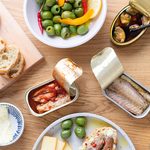10 ways to reduce kitchen waste
Bringing your own bag to the grocery store is just the first step. Here are 10 more ways to reduce the amount of waste that comes out of your kitchen

Source: Web exclusive: September 2009
As you begin your new green shopping regimen, you may find that practicing some of the tips below will earn you weird looks from store employees and shoppers. Don’t worry: New ideas are often looked at with mild suspicion, and even simple changes like the ones outlined here can seem like extra work to overworked staff. Fortunately, people adapt. The idea of bringing your own bag for grocery shopping once seemed radical, but it’s become an everyday habit for millions of people. So when shopping with the environment in mind, be brave, organized, and patient with people who may have a different point of view, all of which will go a long way toward convincing people of the worthiness of your cause.
1. Bring your own bags and containers
Plastic bags, cardboard containers and plastic boxes have a long life span. Reuse old plastic bags for holding vegetables and bulk goods when shopping. And then use them again; all they need is a quick rinse or dusting-off between uses. At the farmers’ market, transfer berries out of their cardboard or plastic boxes into a lightweight sealable container and give the disposable box back to the farmer. When buying eggs, bring the carton back to the farmer. At the Union Square farmers’ market in New York, some farmers give a reimbursment for returned egg cartons and cardboard berry boxes. Ideally, it’s good to take along several reusable, washable cotton produce bags. These can be found at health food stores and online.
2. Bring a container for leftovers to restaurants
If every time you go out for Chinese food you’re unable to finish what you ordered, bring along a sealable container and put leftovers in it at the end of the meal. This is a simple way to avoid taking home that cute Chinese food carton, plastic soy sauce packet, bag, fork and knife, all of which will go into a landfill.
Not so long ago, people didn’t leave bread in the bread basket at a restaurant but instead took it home, as the idea of throwing away good food was unheard of. (Interestingly, in Europe, restaurant servings are not as large as they are in the United States, so take-home containers are practically nonexistent. And in many countries, like Italy, bread costs extra.) I have even brought my own container to the gelato shop on the corner to avoid using the standard disposable plastic cup with a plastic spoon. (Yes, I did get very strange looks, but I was able to have my ice cream and eat it, too!)
3. Carry a steel Thermos
How often do you buy a cup of coffee to go? Or a plastic bottle of water at the beginning of the day, or when setting out on a hike? Cups and bottles get discarded, and even the few that get recycled still carry a high cost in the fossil fuel production required to make and transport them, as well as in the recycling process itself. By contrast, a steel Thermos is light and easy to sanitize’just wash it out after using, and boil the parts every few weeks. Such a small act could make a huge difference to the environment. As more people are putting this method into practice, more coffee shops around the country are encouraging the trend by giving a discount for bringing your own mug.
4. Carry your own silverware
Even at the most eco-conscious health food restaurants and buffets’where they admirably serve food on compostable paper plates’plastic cutlery and disposable chopsticks are often used. All of that plastic, paper, bamboo, and wood ends up in a landfill. Carrying a personal set of cutlery as an environmental act started several years ago in China, where activists have taken to bringing their own reusable chopsticks stored in cloth bags into restaurants, in the hope of preserving some of the 25 million trees that are cut down each year to make chopsticks. It’s easy to fashion a makeshift carrying case by wrapping cutlery in a clean dish towel, or get fancy and make a washable cloth pouch that snaps shut. This small act could make a big change; activists in South Korea have succeeded in getting disposable chopsticks banned in many restaurants, where metal ones are now used instead.
5. Avoid using plastic around food
Plastic food storage containers can leach many harmful toxins into food. Aside from harming our health through contact with our food, plastic has many other unfortunate characteristics: It releases chemicals such as benzene and dioxin into the air as it is manufactured; it is largely considered disposable; it takes hundreds of years to decompose; and it remains a danger to the water table once it’s in a landfill. Happily, there are several viable alternatives to plastic food storage containers, such as glass, metal, and ceramic bowls with plastic lids. These choices are all heavier and more expensive than plastic, but they are safe and will last indefinitely.
6. Bring your lunch to work
Instead of buying lunch on the go, spend 20 minutes the night before packing a homemade lunch. This is a great way to avoid all the extra packaging that accompanies takeaway, and at the same time save enough money for a meal in a nice restaurant once a week. There are many alternatives to carrying your lunch in plastic containers. Pyrex bowls with plastic lids are a good choice, and stainless-steel ‘tiffin’ sets with several stackable bowls, like the ones used in India, can be found on the Internet. Food-safe ceramic containers are another option. For wrapping sandwiches, the washable Wrap-N-Mat, available through online retailers, closes with Velcro and unfolds so it can be used as a placemat.
7. Soak beans and grains before cooking
Soaking certain foods reduces cooking time as well as gas or electric use. In the case of beans, which soak up a lot of water as they cook, it can also mean less water use. It takes only a few seconds to throw a cup of beans or grains into a bowl of water before going to bed, and it will cut the cooking time by half. But even soaking for an hour can make a big difference. This method applies to noodles, lentils, and white rice, foods that you wouldn’t normally think to soak. If you have trouble getting beans to cook all the way through, try boiling them for 10 minutes, then letting them soak in the hot water with a tablespoon of apple cider vinegar for 1 to 12 hours. Drain and then cook the beans as usual. Another energy-saving approach is to use a pressure cooker. Pressure cookers cook foods in roughly a third of the time required for conventional pots and pans. There are several high-quality models available that are either plugged in or used on the stovetop.
8. Reduce or eliminate paper towel use
Like any paper product, paper towels are made from trees, and most wind up in landfills. Paper towels seem irreplaceable for certain tasks, but you can significantly reduce their use in the kitchen. A decent sponge can last a long time’simply boil it for a few minutes to kill germs and odours. Use a wire rack instead of paper towels for draining fried foods. For cleaning, check out microfibre cloths, which can be used multiple times; they are available in hardware and home supply shops as well as natural grocers. If you have to use paper towels, use ones made from recycled paper. Paper towels can be composted too, so unless you have a large amount, there’s no need to throw them in the trash.
9. Use all of your food
The average American household throws an estimated 14 percent of its purchased food into the garbage. This figure includes items that have never been opened, small amounts left in the bottoms of containers, and food that has simply gone bad. Clearly, there’s money and resources to be saved here. Keep useful scraps like chicken bones, shrimp shells, or vegetable trimmings, all of which can be made into flavourful stocks; you can even use apple cores, tomato trimmings, corn husks, mushroom stems, and cheese rinds: simply cover the ingredients with water, bring to a boil, and simmer for approximately 15 minutes. (Some scraps, however, like kale stalks, will become bitter, so do a little research if you’re new at making stock.) Try to shop practically, and only buy produce when you know you’ll have time to cook; fresh food can go bad quickly. Find out which parts of your produce are edible, and enjoy using tasty ingredients, such as beet greens, broccoli stalks, or squash seeds that often get thrown away. And what you can’t use, compost.
10. Shop in bulk
Bulk shopping helps to eliminate excess packaging and saves money. Both traditional supermarket chains and boutique health food stores sell food in bulk, but it’s not an option in enough stores. If the store where you shop sells food in bulk, bring paper or plastic bags for items like bread, grains, and other dry goods. Standard half-pint-, pint-, and quart-size bulk containers can be reused for buying olives and other nondry bulk items. If you don’t own standard-size containers, bring glass jars or other portable containers. Make sure to weigh them and label them clearly with their weight measurements.
Excerpted from Lucid Food by Louisa Shafia Copyright © 2009 by Louisa Shafia. Excerpted by permission of Ten Speed Press, a division of Random House of Canada Limited. All rights reserved. No part of this excerpt may be reproduced or reprinted without permission in writing from the publisher.




